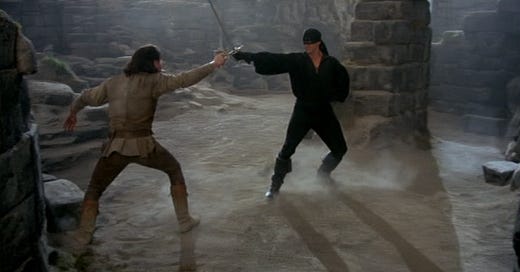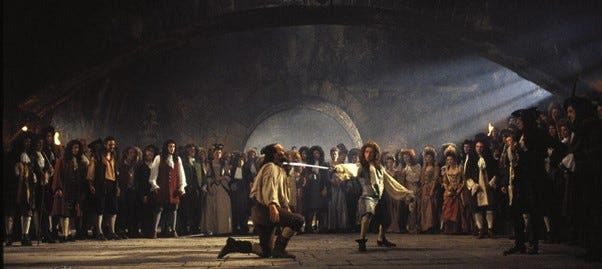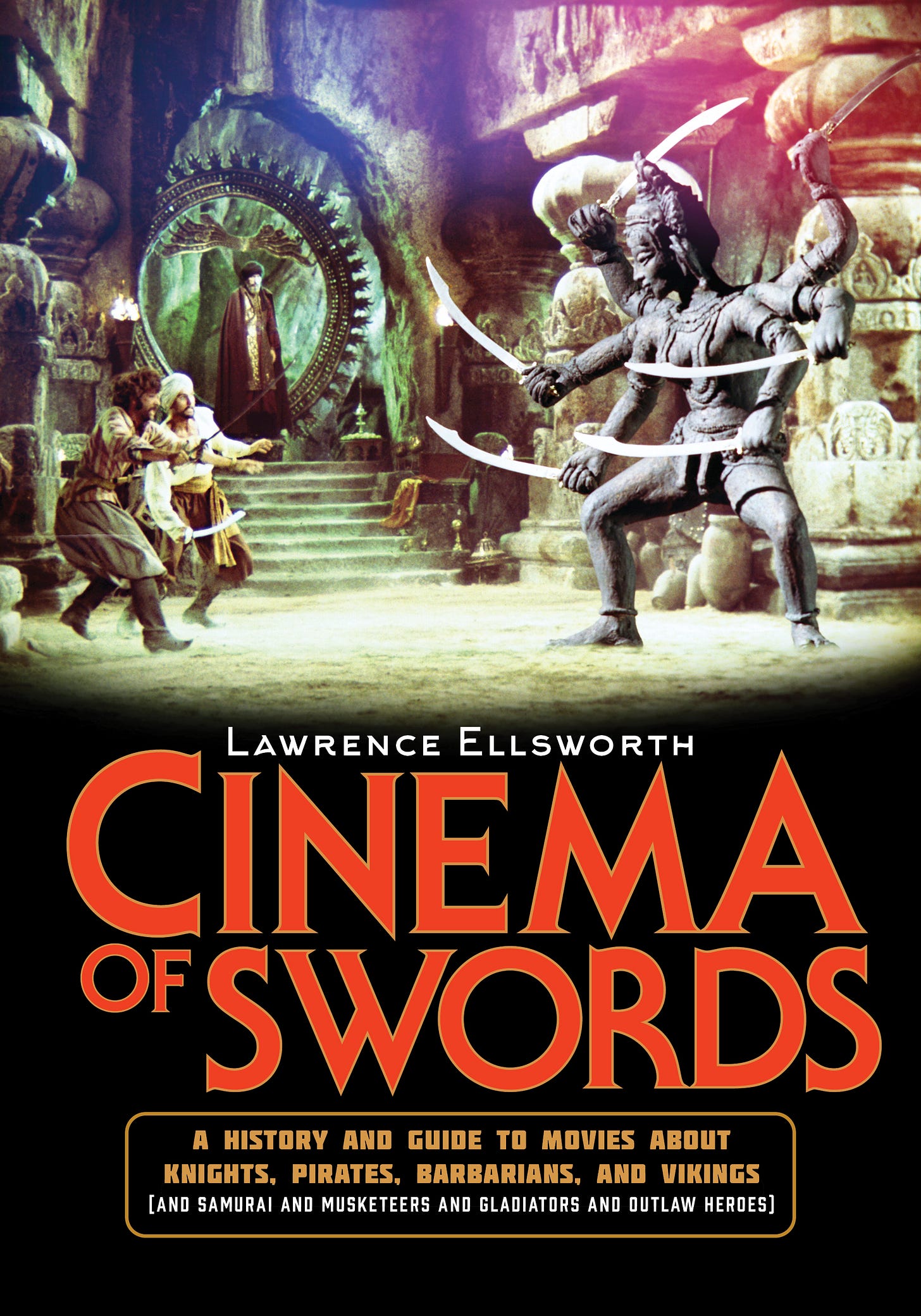Cinema of Swords
A Popular Guide to Movies about Knights, Pirates, Samurai, and Vikings (And Barbarians, Musketeers, Gladiators, and Outlaw Heroes)
By Lawrence Ellsworth
Welcome to the Cinema of Swords Substack! This series is a companion and expansion to my Cinema of Swords hardcover (Applause Books, 2023), which collects over 400 tasty mini-reviews of screen swashbucklers from the Silent Era through The Princess Bride.
This Substack builds on that foundation, continuing forward with reviews of swordplay movies and TV shows from the ‘90s to the present. Every week I’ll present two to four illustrated reviews on a common theme written both to inform and to entertain.
If you enjoyed the contents of the book, this weekly series will give you plenty more of the same. (And if you haven’t seen the book, look for it wherever you do your book shopping!)
Kilts Akimbo
There was a strange cluster of medieval Scots-oriented historical adventure films in the mid-‘90s, ranging from very good to very bad, but don’t worry, lads and lassies, we’re here to tell you which to watch and which to avoid. These films, especially Braveheart, made an impression about the burning Scottish desire for independence from the English that has scarcely faded in the years since. Coincidentally, I was just in Edinburgh last week, a wonderful city, so this post has a timely relevance to me, at least. I hope you enjoy it.
Braveheart
Rating: ***
Origin: USA, 1995
Director: Mel Gibson
Source: 20th Century Fox DVD
To be clear, though it’s presented as a historical action film, Braveheart’s connections to history are tenuous at best, and so much has been written about what it gets wrong that the subject is practically its own literary subgenre. We’ll address it instead as an action fable, an extended American male fantasy of the lone hero punished for standing up against oppression, sung to a Scottish tune played on the bagpipes.
Mel Gibson produced, directed, and stars as the Scots freedom fighter William Wallace, who is portrayed as bold, determined, pious, vengeful, and above all single-mindedly devoted to the cause of Scottish liberation from their English overlords. Screenwriter Randall Wallace based his story on the feelings he had when reading the 15th-century poet Blind Harry’s hagiographic epic about William Wallace, which Randall said “spoke to his heart.” The result is a sweeping romantic epic about the heart of a single man, an imagined journey through love, loss, violent revenge, popular acclaim, and a martyr’s death while spitting in the eye of fate and his enemies.
That story is certainly told effectively by Gibson, with the help of the stunning scenery of Scotland and Ireland and a cast of thousands, including a brigade of the Irish Defence Forces clad in English armor and Scottish tartans, all cheering lustily before engaging in bloody mutual slaughter. Besides skirmishes, ambushes, and sieges, there are three big open field battles that are the centerpieces of the movie, in which Wallace is sequentially victorious, victorious and then betrayed, and finally just betrayed. These battles are all enthusiastically presented, genuine crowd pleasers, with solid fight direction by sword master Nick Powell, though for my taste Gibson as a director is way too heavy-handed with the slo-mo.
This movie has only one star in its spotlight, with all other roles designed to augment rather than distract from the lead, the conspicuous exception being Patrick McGoohan’s icy performance as England’s King Edward I. He rules his every scene with little more than the flick of an eyebrow or the twitch of a cheek. And Catherine McCormack as Wallace’s first love Murron is touching in her all too brief appearance.
The final scenes are of Wallace’s public death by torture at the hands of his heartless enemies, scenes this reviewer finds loathsome and unforgivable. Gibson conceitedly wallows in self-righteous martyrdom, deliberately equating his character’s noble death with the suffering of Christ on the cross, and the insufferable gall of it sticks in the craw and taints the entire movie with its pompous vainglory. Gross.
When first released, this film was popular as all get-out, even winning the Oscar for Best Picture, but it’s now thirty years old so you might not have seen it. So, the question is, should you? Probably; the parts that work are worth a look and the thing has become a cultural touchstone you should be familiar with. But you’ll enjoy Rob Roy (1995), made in the same year, much more, even if you’ve seen it before. Trust me.
The Bruce
Rating: *
Origin: UK, 1996
Directors: Bob Carruthers and David McWhinnie
Source: Black Hill DVD
I would be delighted to be able to report that a movie about medieval Scotland’s struggle with England starring Cinema of Swords favorites Oliver Reed and Brian Blessed is a hidden gem that’s worth your time, but I’m cheated of that pleasure by cruel fate and lousy filmmaking. This is a biopic of the rise of Robert the Bruce (Sandy Welch) to become King Robert I of Scotland, culminating in his underdog victory over superior English forces at the Battle of Bannockburn (1314), a perfectly fine subject for a historical adventure, especially in the wake of the global success of Braveheart (1995), to which this film acts as a sort of sequel.
But there are problems, the first and foremost being a general lack of technical competence on the part of the filmmakers. The cinematography is dim and grainy, the camera work is awkward, and the actors are poorly miked, their voices varying from loud and harsh to muffled and inaudible, sometimes in the same sentence. The production has the look of a low-budget docudrama, which makes sense considering the director’s previous career was shooting historical documentaries for TV. The knights and men-at-arms resemble Renaissance Faire re-enactors taking care, in the action sequences, not to injure each other with their replica weapons. Scene changes are often abrupt and confusing, and characters come and go without much explanation, making the story sufficiently hard to follow that an intrusive narrator was added in post-production, a desperate device to make sure the viewer knows what’s going on.
The filmmakers also did themselves no favors by casting previously unknown Sandy Welch as Bruce, because he’s a singularly unappealing lead, sullen, humorless, and strident. The rest of the cast actually aren’t bad at all, but with Welch the film has an empty nullity at its center. Brian Blessed is fine as England’s King Edward I, pursuing his vendetta against the Scots king until he expires from sheer orneriness, handing the reins to Edward II (Richard Brindlecombe), who continues the family feud. King Robert is supported by Oliver Reed as Bishop Wishart, a hardboiled old ex-Crusader who champions the Bruce even after he tactlessly murders one of his treacherous rivals in a church, i.e., hallowed ground. And Hildegarde Neil does all right with what she’s given in the role of Queen Eleanor of Castile, wife of Edward I.
However, what everyone has come for is the Battle of Bannockburn, and here again the film simply doesn’t deliver. Though it conveys a sense of the chaos of a medieval battle, that might be accidental as the directors struggle to make a coherent story of the clash. A key aspect of that battle was the superiority of the English longbowmen until they were neutralized by the Scottish cavalry, which is remarked upon in the film, but no archery is shown. Instead, that intrusive narrator tells us that the English archers “turned the sky dark with their shafts,” but nope, sorry, without visual backup that simply doesn’t cut it. Bad storytelling, lads. Go back to documentaries.
Rob Roy
Rating: *****
Origin: USA, 1995
Director: Michael Caton-Jones
Source: MGM Blu-ray
Though released at nearly the same time as the more popular Braveheart (1995), Rob Roy is a better film in almost every way. Both movies are about Scottish outlaws resisting English occupation, and though Rob Roy, like Braveheart, has a strong male lead, in this case Liam Neeson, it tells a much richer story of five people rather than one, each of whom is strongly cast and powerfully performed—indeed, Tim Roth, who plays Archie Cunningham, one of the villains, was nominated for an Oscar as Best Supporting Actor and won the equivalent award at the BAFTAs.
The original story by screenwriter Alan Sharp is loosely based on the life of Robert Roy McGregor (1671-1734), who was also the subject of one of Walter Scott’s most popular historical adventure novels. McGregor (Leeson) is a Highland clan leader and occasional cattle raider whose people are aggressively taxed by the English nobility into near starvation. To raise money for the clan, McGregor comes up with a scheme for a high-stakes cattle drive and borrows £1000 from the local lord, the Marquess of Montrose (John Hurt), to finance it. But two of Montrose’s sleazy retainers, his factor Killearn (Brian Cox) and the duelist Cunningham (Roth), rob and kill one of McGregor’s men for the money, hiding the body so it looks like the Scot ran off with the gold, and Montrose then moves to foreclose on McGregor’s land. This Cunningham does for him with a troop of redcoats and a heavy hand, raping McGregor’s wife Mary (Jessica Lange), killing their livestock and burning the family farm. Vengeance is sworn.
Those are the bare bones of the plot, but the movie is really about the relationships between Rob and Mary on the Scot side and Montrose, Cunningham, and Killearn on the English. The latter trio are three of the finest screen villains since Rains, Rathbone, and Cooper in The Adventures of Robin Hood (1938), though Hurt, Roth, and Cox have them beat in range and subtlety. They’re deliciously wicked. However, the heart of the film is the love story of a husband and wife: Rob, good-hearted, devoted to honor and honesty, and rather gullible, and Mary, fierce and loyal, who sees farther than he does and more clearly. In the end she’s the one who finds a way for the family out of the mess the men have gotten it into.
This is also a movie about swordplay, and every time the blades come out it’s another step in setting up the duel between McGregor and Cunningham at the climax of the film. Rob Roy is lucky enough to have as its fight director William Hobbs, the leading theatrical swordmaster of his generation. His choreography, and the powerful physical performances of Neeson and Roth, make that climactic duel one of the greatest sword fights ever filmed. It’s masterly, both thrilling and frightening, and it provides the emotional catharsis the film’s strong conflict demands.
Kudos as well to the crisp cinematography by Karl Lindenlaub of the stunning landscapes of the Scottish Highlands, and to the visual composition and framing by director Michael Caton-Jones, though he does let the pacing flag a bit during the villains’ scam and conspiracy. If you haven’t seen this film, it’s a pleasure to recommend it to you—and if you have, it might be time for a re-watch, because it holds up well to multiple viewings.
Next Week: Three Trainwrecks, swashbuckling flops and disasters. Don’t miss it!
About Lawrence Ellsworth
Lawrence Ellsworth is the historical fiction nom de plume of Lawrence Schick, author of The Rose Knight’s Crucifixion and editor of The Big Book of Swashbuckling Adventure. See my website at swashbucklingadventure.net.
My current ongoing project is compiling and translating new, contemporary editions of all the books in Alexandre Dumas’s Musketeers Cycle, a series that when complete will fill nine volumes. Volume 7, Devil’s Dance, is currently being published in serial form on the Substack platform. Volumes 8 and 9 are forthcoming. Check out the series at musketeerscycle.substack.com.
As Lawrence Schick, I’m a writer and game designer primarily associated with narrative or role-playing games, a career I’ve pursued for over forty years, starting in the late 1970s working for Dungeons & Dragons co-creator Gary Gygax, moving into video games in the ‘80s and then online role-playing games in the ‘90s. I was lead writer and “loremaster” for The Elder Scrolls Online for over nine years, and most recently I’ve returned to D&D as the Principal Narrative Designer for Larian Studios’ smash hit Baldur’s Gate 3.
Copyright © 2023 Lawrence Schick. All rights reserved.










Okey-doke! Interesting takes! I still have a VHS copy of The Bruce for some reason, but need to send it to Half-Price Books. It's lousy. I never upgraded my VHS tapes of Braveheart or Rob Roy to DVD, I let those go, neither really appealed to me after a couple of viewings. Braveheart's failings are well documented, as noted. And Rob Roy wasn't what I wanted in a Rob Roy movie, I would have preferred a swashbuckler in the Richard Lester style. This Rob Roy was humorless and grim. Have you already covered the Disney Rob Roy, the much earlier one? I seem to recall that review, it must be in The Book!
The Piper has spoken!
Oh! You missed "Chasing the Deer", another obscure 1990s Scottish historical film, with Brian Blessed! It's not very good and takes the unusual stance (for a Jacobite movie) of having anti-Jacobite characters as the main protagonists. Even Bonnie Prince Charlie is only a bit player. It's a fairly sour affair but for completist's sake you might want to hunt it down and report.